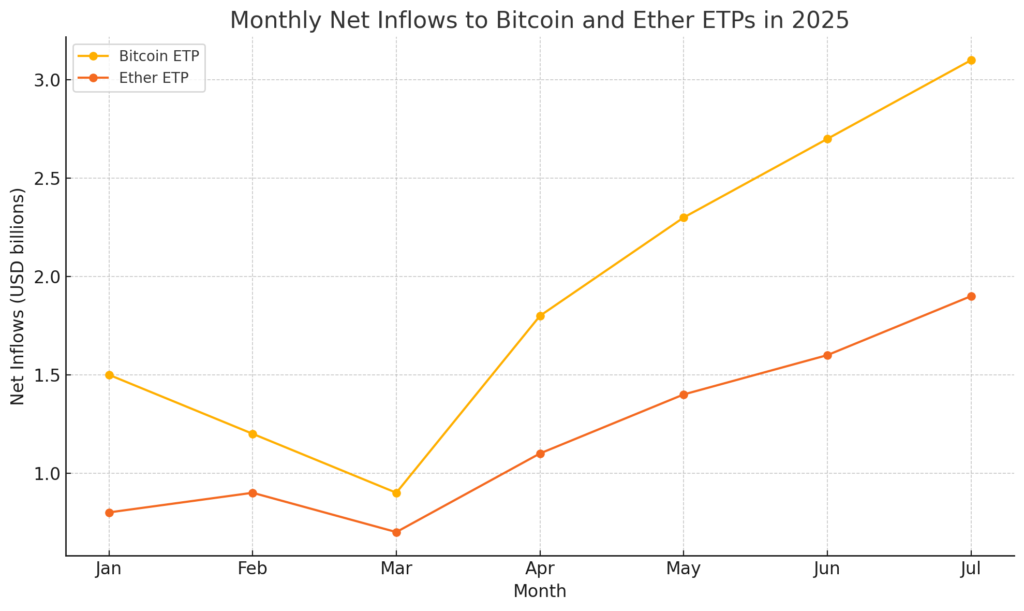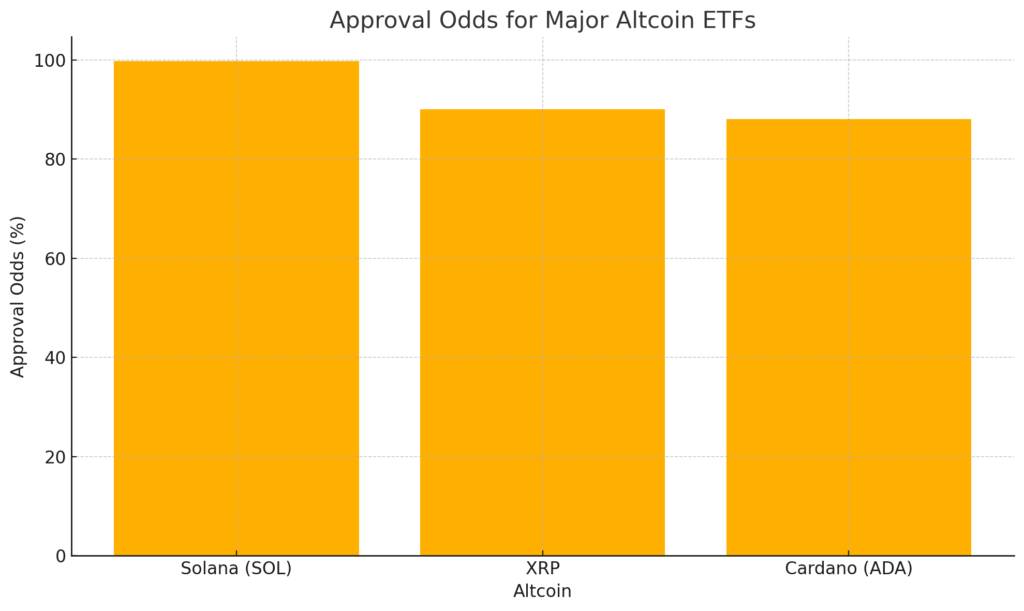
Key Takeaways:
- SEC’s New In-Kind Approval: Allows Bitcoin and Ether ETPs to issue and redeem shares using actual cryptocurrency instead of cash.
- Streamlined Operations: Reduces costs and settlement times, aligning crypto ETPs with traditional commodity ETFs.
- Investor Benefits: Tighter price tracking, lower fees, and enhanced market transparency.
- Robust Q2 2025 Inflows: Bitcoin ETPs saw over $9 billion inflows; Ether ETPs logged $812 million over 14 trading days.
- Altcoin ETF Prospects: Solana spot ETFs nearly certain (99.7% odds); XRP and Cardano also poised for approval.
- Broader Implications: Opens door for Solana, XRP, and other altcoin ETPs; bolsters blockchain’s utility in institutional contexts.
1. A Landmark Approval for Crypto ETPs
On July 29, 2025, the U.S. Securities and Exchange Commission (SEC) officially adopted an “in-kind” model for crypto exchange-traded products (ETPs), permitting the creation and redemption of shares via transfer of the underlying asset—Bitcoin (BTC) or Ethereum (ETH)—rather than through cash transactions. This move bridges a long-standing gap between crypto ETPs and commodity-based ETFs, signaling a transformative shift in regulatory treatment.
Under the prior regime, all crypto ETP creations and redemptions required cash settlement, introducing additional conversion steps and potential slippage. With in-kind approval, authorized participants can now deliver or receive actual BTC or ETH, streamlining operations at the issuer level and reducing counterparty risk.
2. How In‑Kind Creation & Redemption Works
Mechanics:
- Creation: An authorized participant delivers a block of the underlying crypto (e.g., 50 BTC) directly to the ETF sponsor’s custodian. In exchange, the sponsor issues new ETP shares.
- Redemption: The process is reversed: an authorized participant surrenders ETP shares to the sponsor and receives the equivalent amount of crypto.
Comparison with Cash Model:
- Cash Model: Involves selling or purchasing crypto on the open market to match net share creation/redemption, incurring trading fees and execution risk.
- In-Kind Model: Eliminates these steps, lowering operational friction and aligning fund share creation with actual asset movements.
3. Benefits for Issuers and Investors
- Cost Reduction: By cutting out the market-sell/purchase leg, issuers save on trading commissions and bid-ask spreads. These savings can translate into lower expense ratios for investors.
- Improved Tracking: Tighter correlation between ETP share price and NAV ensures that premium/discount fluctuations narrow, boosting investor confidence.
- Faster Settlement: Direct asset transfers can settle on-chain within hours rather than days, enhancing liquidity and fund responsiveness.
SEC Chair Paul Atkins highlighted that the in-kind process “lowers costs and allows for more efficient fund operations,” positioning crypto ETPs alongside mainstream commodity funds in terms of industry standards.
4. Q2 2025 Market Response & Flows
Crypto ETPs have already demonstrated strong asset-gathering momentum in 2025. Bitcoin ETPs pulled in over $9 billion in inflows during Q2 alone, as investors reallocated from traditional stores of value like gold. Meanwhile, Ether spot ETFs booked $812 million in inflows across 14 consecutive days—a record for 2025.
Figure 1: Monthly Net Inflows to Bitcoin and Ether ETPs in 2025

Figure 1 illustrates the steady rise in monthly net inflows, driven by growing institutional acceptance and anticipation of regulatory enhancements.
5. The Next Frontier: Altcoin ETPs
Building on the in-kind precedent, market participants now eye the approval of spot ETPs for major altcoins:
- Solana (SOL): Odds of SEC approval near 99.7%, driven by Polymarket data and robust staking yield prospects.
- XRP & Cardano (ADA): Bloomberg analysts uplift approval probabilities to 90% and 88%, respectively, as the SEC solicits public comments on disclosure rules.
Figure 2: Approval Odds for Major Altcoin ETFs

If green-lit, altcoin ETPs will expand choice for yield-seeking and diversification-focused investors, while setting new benchmarks for blockchain-based fund structures.
6. Practical Implications for Blockchain Utilization
The in-kind framework not only reshapes fund mechanics but also underscores evolving blockchain use cases:
- Institutional Custody Solutions: Demand surges for regulated crypto custody providers capable of large-block transfers.
- On-Chain Settlement Workflows: Issuers collaborate with validators or custodial blockchains to ensure seamless cross-chain transactions.
- Tokenized ETP Shares: Potential emergence of secondary markets on decentralized exchanges, leveraging token standards for ETF share representation.
Blockchain developers and DeFi platforms can leverage these trends to build complementary services—such as automated market-makers for ETP share tokens or treasury management protocols for custodians.
Conclusion
The SEC’s formal approval of in-kind creation and redemption for crypto ETPs marks a pivotal moment in digital asset maturation. By aligning Bitcoin and Ether ETFs with commodity standards, the rule change slashes costs, enhances market fidelity, and paves the way for altcoin ETP innovations. With $9 billion and $812 million inflows into Bitcoin and Ether products in Q2 2025, investor appetite is evident. As Solana, XRP, and Cardano funds edge closer to launch, blockchain’s institutional integration will deepen—fueling practical use cases and broadening opportunities for revenue generation in the evolving crypto landscape.

